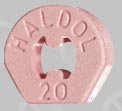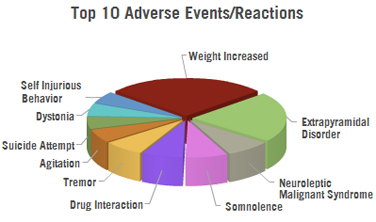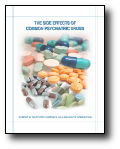 The risks of these drugs are provided so the public can make informed, educated decisions. Haloperidol is an older antipsychotic drug. The U.S. Food and Drug Administration issued a black box warning about antipsychotics increasing the risk of death in the elderly with dementia. It is also known as Aloperidin, Haldol, Halomonth, Haloperidol, Neoperidol, Serenace and Serenase.
The risks of these drugs are provided so the public can make informed, educated decisions. Haloperidol is an older antipsychotic drug. The U.S. Food and Drug Administration issued a black box warning about antipsychotics increasing the risk of death in the elderly with dementia. It is also known as Aloperidin, Haldol, Halomonth, Haloperidol, Neoperidol, Serenace and Serenase.
To see the total figures from IQVia on the number of people taking antipsychotic drugs in the U.S., click here.
Please note: No one should attempt to get off of psychiatric drugs without a doctor’s supervision. To help find medical practitioners in your area, click here.
Haldol Drug Warnings:
There have been 10 drug regulatory agency warnings from four countries (Australia, Canada, New Zealand and United States) on Haldol (or haloperidol). These include the following (note that some warnings cite more than one side effect, so the list below may not be equal to the total number of warnings):
3 warnings on Haldol causing cardiovascular disorders
3 warnings on Haldol causing death or increased risk of death
3 warnings on Haldol causing muscle problems
3 warnings on Haldol causing heart problems
2 warnings on Haldol causing blood pressure changes or high or low blood pressure
2 warnings on Haldol causing newborn complications (including infant withdrawal symptoms)
2 warnings on Haldol causing nervous system disorders
1 warning on Haldol causing risk of fractures
1 warning on Haldol causing involuntary movements
1 warning on Haldol causing sexual dysfunction
Haldol Drug Studies:
There have been 35 studies done in 16 countries (Australia, Brazil, Canada, Denmark, Finland, France, Germany, Italy, Netherlands, South Korea, Sweden, Switzerland, Taiwan, Turkey, United Kingdom and United States) on Haldol (or haloperidol). These include the following (note that some studies cite more than one side effect, so the list below may not be equal to the total number of studies):
14 studies on Haldol causing cardiovascular disorders
13 studies on Haldol causing death or increased risk of death
6 studies on Haldol causing heart problems
4 studies on Haldol causing diabetes
2 studies on Haldol causing metabolic disorders
2 studies on Haldol causing skin conditions
2 studies on Haldol causing heart attacks
2 studies on Haldol causing stroke
1 study on Haldol causing nervous system disorders
1 study on Haldol causing involuntary movements
1 study on Haldol causing weight gain
1 study on Haldol causing newborn complications
1 study on Haldol causing pregnancy complications
1 study on Haldol causing muscle problems
1 study on Haldol causing Neuroleptic Malignant Syndrome (a life-threatening neurological disorder)
1 study on Haldol causing allergic reactions
1 study on Haldol causing premature birth
1 study on Haldol causing infant withdrawal symptoms
1 study on Haldol causing brain shrinkage or other structural brain changes
1 study on Haldol causing lack of efficacy
1 study on Haldol causing blood pressure changes or high or low blood pressure
1 study on Haldol causing pneumonia
1 study on Haldol causing lowered bone mass
Adverse Reaction Reports Filed with the US FDA: There have been 3,850 adverse reactions reported to the US FDA in connection with Haldol (haloperidol).
The FDA estimates that less than 1% of all serious events are ever reported to it, so the actual number of side effects occurring are most certainly higher.
- 745 cases of increased weight
- 595 cases of extrapyramidal disorder (movement disorder)
- 212 cases of neuroleptic malignant syndrome (a life-threatening neurological disorder)
- 200 cases of somnolence
- 193 cases of tremors
- 160 cases of agitation
- 148 cases of suicide attempts
- 146 cases of dystonia (abnormally tight muscles)
- 143 cases of self-injurious behavior
- 114 cases of cognitive disorder
Documented Side Effects of Haldol:
Source: Physicians Desk Reference, National Institutes of Health’s Medline Plus, and/or the drug label.
Agitation
Anxiety
Blurred vision
Breast enlargement or pain
Breast milk production
Breathing difficulties
Catatonic-like behavioral states
Confusion
Decreased sexual ability in men
Decreased vision, especially at night
Depression
Difficulty breathing or swallowing
Difficulty falling asleep or staying asleep
Dizziness
Drowsiness
Dystonia
Euphoria
Extrapyramidal symptomsExtremely high fever
Eye problems
Fast or irregular heartbeat
Fine, worm-like tongue movements
Grand mal seizures/Seizures
Hallucinations
Heat stroke
High or low blood pressure
Increased saliva
Inflammation of the lungs
Insomnia
Jaundice
Lethargy
Leukopenia/Neutropenia/Agranulocytosis (reduction in white blood cell count)
Liver problems
Loss of hair
Mood changes
Muscle stiffness
Nervousness
Neuroleptic malignant syndrome
Photosensitivity
Physical/mental impairment
Restlessness
Sudden death
Sweating
Tardive Dyskinesia
Tightness in the throat
Uncontrollable, rhythmic face, eye, mouth, or jaw movements
Unusual, slowed, or uncontrollable movements of any part of the body
Vertigo
Withdrawal symptoms
Click here to learn more >>
This brochure is a simple guide that documents the dangerous and deadly side effects of the drugs prescribed to millions of men, women and children diagnosed with bogus mental disorders.



 Download The Side Effects of Common
Download The Side Effects of Common
SHARE YOUR STORY/COMMENT